ECO mode FORD SUPER DUTY 2008 2.G Diesel Supplement Manual
[x] Cancel search | Manufacturer: FORD, Model Year: 2008, Model line: SUPER DUTY, Model: FORD SUPER DUTY 2008 2.GPages: 96, PDF Size: 0.64 MB
Page 2 of 96
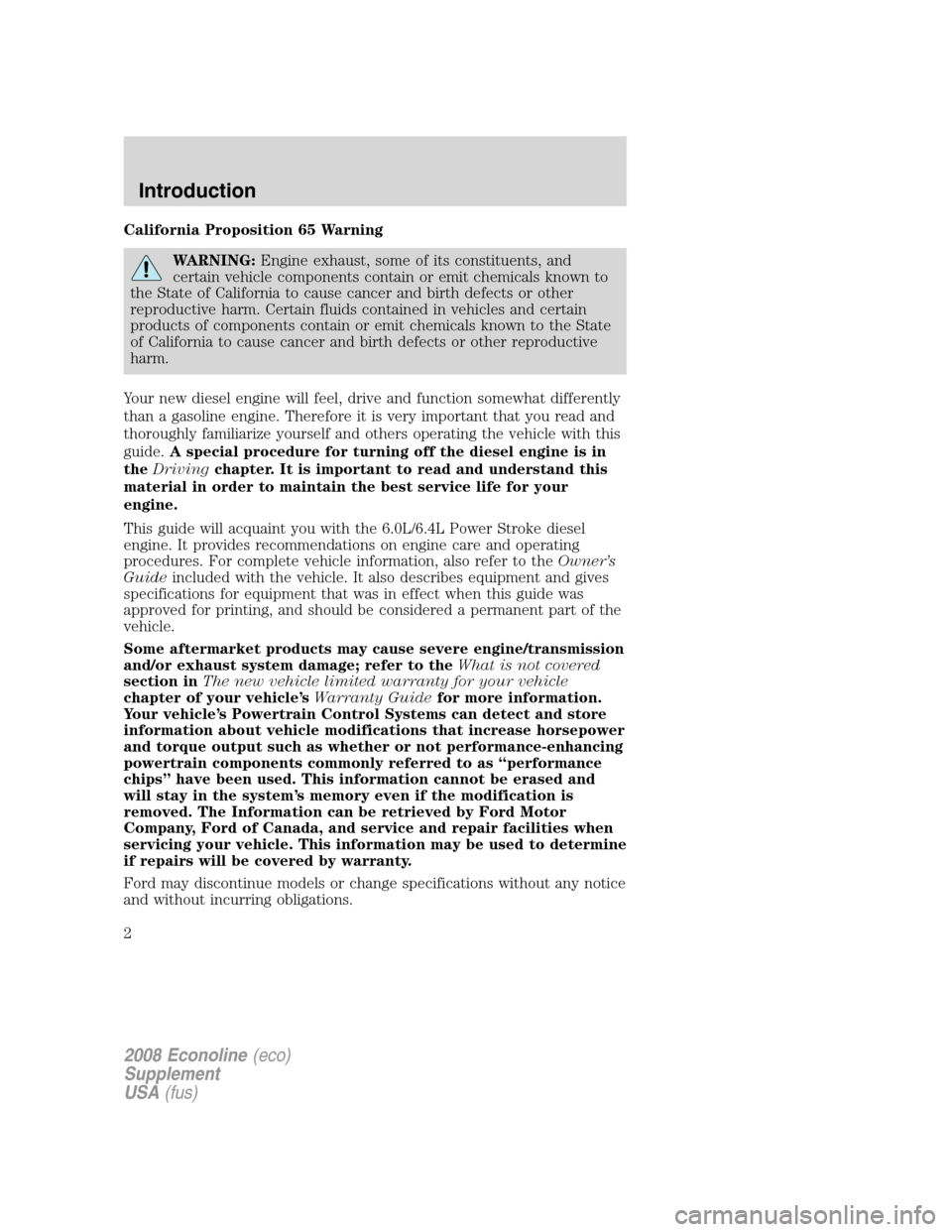
California Proposition 65 Warning
WARNING:Engine exhaust, some of its constituents, and
certain vehicle components contain or emit chemicals known to
the State of California to cause cancer and birth defects or other
reproductive harm. Certain fluids contained in vehicles and certain
products of components contain or emit chemicals known to the State
of California to cause cancer and birth defects or other reproductive
harm.
Your new diesel engine will feel, drive and function somewhat differently
than a gasoline engine. Therefore it is very important that you read and
thoroughly familiarize yourself and others operating the vehicle with this
guide.A special procedure for turning off the diesel engine is in
theDrivingchapter. It is important to read and understand this
material in order to maintain the best service life for your
engine.
This guide will acquaint you with the 6.0L/6.4L Power Stroke diesel
engine. It provides recommendations on engine care and operating
procedures. For complete vehicle information, also refer to theOwner’s
Guideincluded with the vehicle. It also describes equipment and gives
specifications for equipment that was in effect when this guide was
approved for printing, and should be considered a permanent part of the
vehicle.
Some aftermarket products may cause severe engine/transmission
and/or exhaust system damage; refer to theWhat is not covered
section inThe new vehicle limited warranty for your vehicle
chapter of your vehicle’sWarranty Guidefor more information.
Your vehicle’s Powertrain Control Systems can detect and store
information about vehicle modifications that increase horsepower
and torque output such as whether or not performance-enhancing
powertrain components commonly referred to as “performance
chips” have been used. This information cannot be erased and
will stay in the system’s memory even if the modification is
removed. The Information can be retrieved by Ford Motor
Company, Ford of Canada, and service and repair facilities when
servicing your vehicle. This information may be used to determine
if repairs will be covered by warranty.
Ford may discontinue models or change specifications without any notice
and without incurring obligations.
2008 Econoline(eco)
Supplement
USA(fus)
Introduction
2
Page 4 of 96
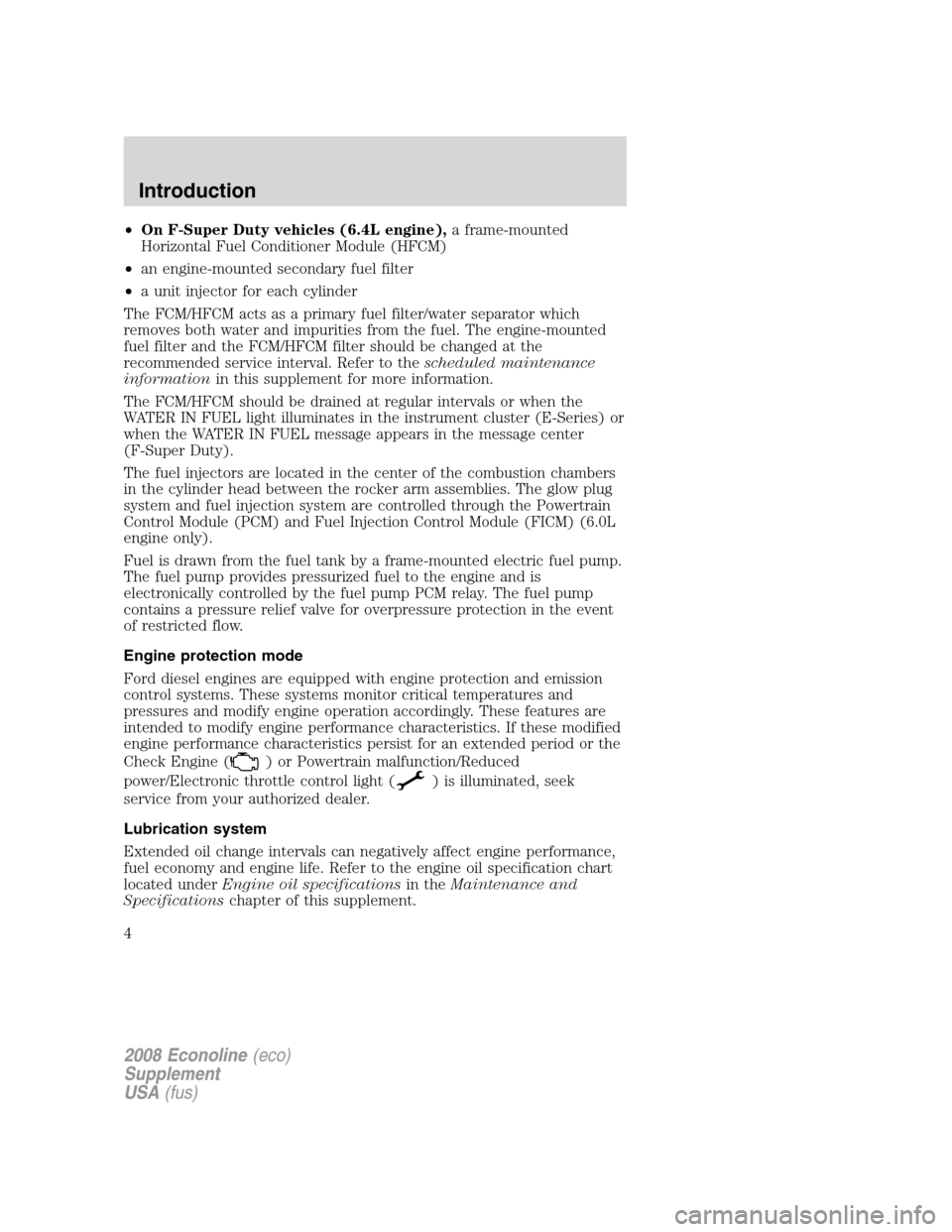
•On F-Super Duty vehicles (6.4L engine),a frame-mounted
Horizontal Fuel Conditioner Module (HFCM)
•an engine-mounted secondary fuel filter
•a unit injector for each cylinder
The FCM/HFCM acts as a primary fuel filter/water separator which
removes both water and impurities from the fuel. The engine-mounted
fuel filter and the FCM/HFCM filter should be changed at the
recommended service interval. Refer to thescheduled maintenance
informationin this supplement for more information.
The FCM/HFCM should be drained at regular intervals or when the
WATER IN FUEL light illuminates in the instrument cluster (E-Series) or
when the WATER IN FUEL message appears in the message center
(F-Super Duty).
The fuel injectors are located in the center of the combustion chambers
in the cylinder head between the rocker arm assemblies. The glow plug
system and fuel injection system are controlled through the Powertrain
Control Module (PCM) and Fuel Injection Control Module (FICM) (6.0L
engine only).
Fuel is drawn from the fuel tank by a frame-mounted electric fuel pump.
The fuel pump provides pressurized fuel to the engine and is
electronically controlled by the fuel pump PCM relay. The fuel pump
contains a pressure relief valve for overpressure protection in the event
of restricted flow.
Engine protection mode
Ford diesel engines are equipped with engine protection and emission
control systems. These systems monitor critical temperatures and
pressures and modify engine operation accordingly. These features are
intended to modify engine performance characteristics. If these modified
engine performance characteristics persist for an extended period or the
Check Engine (
) or Powertrain malfunction/Reduced
power/Electronic throttle control light (
) is illuminated, seek
service from your authorized dealer.
Lubrication system
Extended oil change intervals can negatively affect engine performance,
fuel economy and engine life. Refer to the engine oil specification chart
located underEngine oil specificationsin theMaintenance and
Specificationschapter of this supplement.
2008 Econoline(eco)
Supplement
USA(fus)
Introduction
4
Page 14 of 96
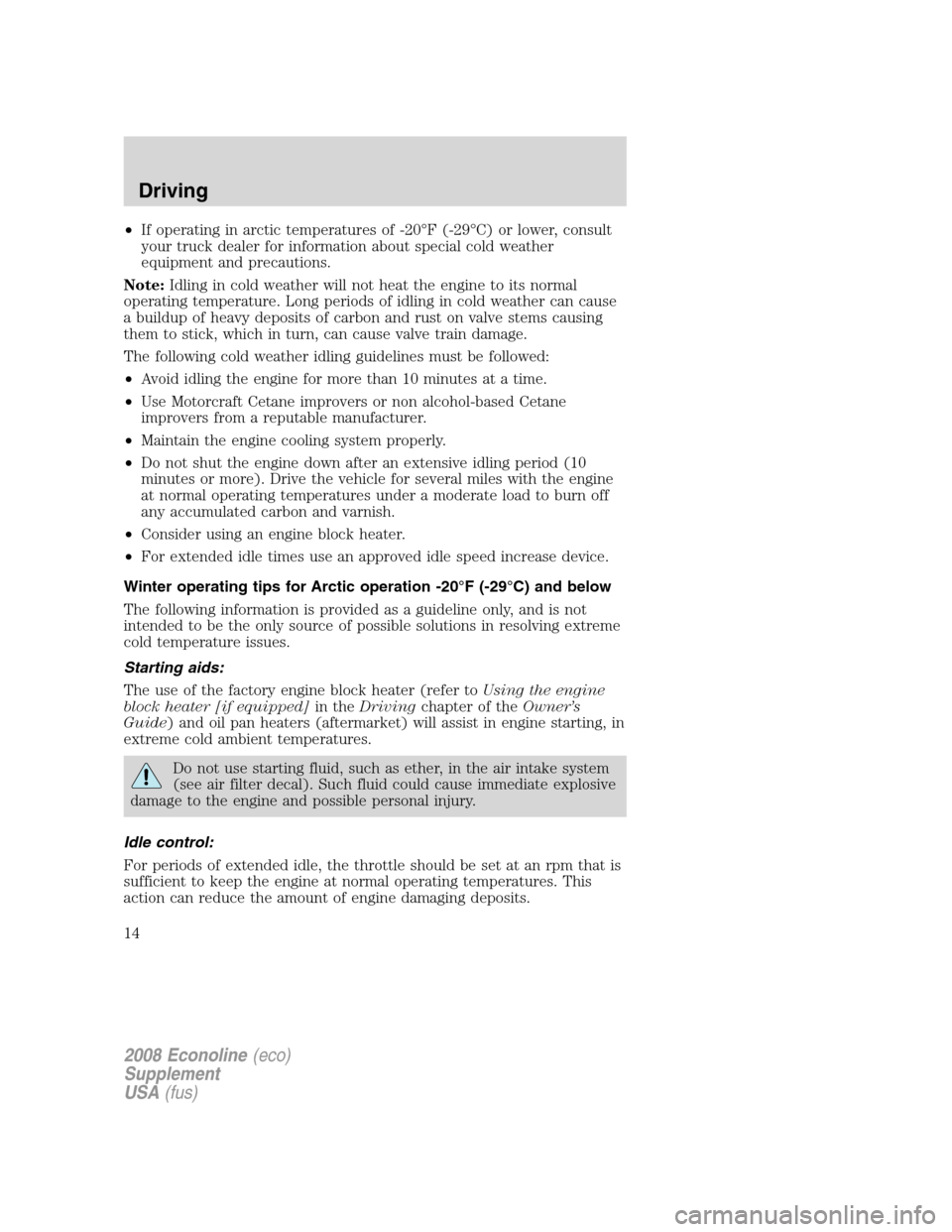
•If operating in arctic temperatures of -20°F (-29°C) or lower, consult
your truck dealer for information about special cold weather
equipment and precautions.
Note:Idling in cold weather will not heat the engine to its normal
operating temperature. Long periods of idling in cold weather can cause
a buildup of heavy deposits of carbon and rust on valve stems causing
them to stick, which in turn, can cause valve train damage.
The following cold weather idling guidelines must be followed:
•Avoid idling the engine for more than 10 minutes at a time.
•Use Motorcraft Cetane improvers or non alcohol-based Cetane
improvers from a reputable manufacturer.
•Maintain the engine cooling system properly.
•Do not shut the engine down after an extensive idling period (10
minutes or more). Drive the vehicle for several miles with the engine
at normal operating temperatures under a moderate load to burn off
any accumulated carbon and varnish.
•Consider using an engine block heater.
•For extended idle times use an approved idle speed increase device.
Winter operating tips for Arctic operation -20°F (-29°C) and below
The following information is provided as a guideline only, and is not
intended to be the only source of possible solutions in resolving extreme
cold temperature issues.
Starting aids:
The use of the factory engine block heater (refer toUsing the engine
block heater [if equipped]in theDrivingchapter of theOwner’s
Guide) and oil pan heaters (aftermarket) will assist in engine starting, in
extreme cold ambient temperatures.
Do not use starting fluid, such as ether, in the air intake system
(see air filter decal). Such fluid could cause immediate explosive
damage to the engine and possible personal injury.
Idle control:
For periods of extended idle, the throttle should be set at an rpm that is
sufficient to keep the engine at normal operating temperatures. This
action can reduce the amount of engine damaging deposits.
2008 Econoline(eco)
Supplement
USA(fus)
Driving
14
Page 15 of 96
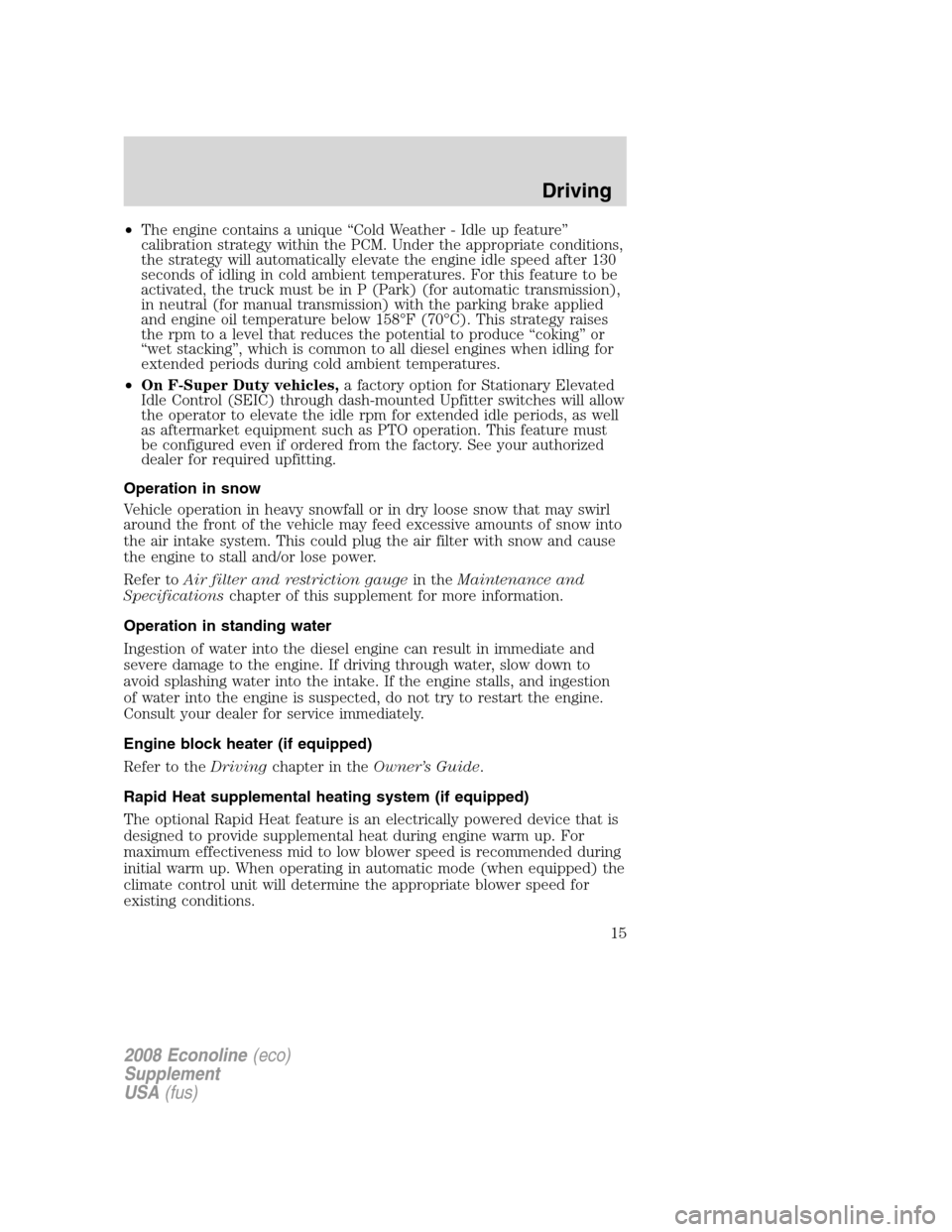
•The engine contains a unique “Cold Weather - Idle up feature”
calibration strategy within the PCM. Under the appropriate conditions,
the strategy will automatically elevate the engine idle speed after 130
seconds of idling in cold ambient temperatures. For this feature to be
activated, the truck must be in P (Park) (for automatic transmission),
in neutral (for manual transmission) with the parking brake applied
and engine oil temperature below 158°F (70°C). This strategy raises
the rpm to a level that reduces the potential to produce “coking” or
“wet stacking”, which is common to all diesel engines when idling for
extended periods during cold ambient temperatures.
•On F-Super Duty vehicles,a factory option for Stationary Elevated
Idle Control (SEIC) through dash-mounted Upfitter switches will allow
the operator to elevate the idle rpm for extended idle periods, as well
as aftermarket equipment such as PTO operation. This feature must
be configured even if ordered from the factory. See your authorized
dealer for required upfitting.
Operation in snow
Vehicle operation in heavy snowfall or in dry loose snow that may swirl
around the front of the vehicle may feed excessive amounts of snow into
the air intake system. This could plug the air filter with snow and cause
the engine to stall and/or lose power.
Refer toAir filter and restriction gaugein theMaintenance and
Specificationschapter of this supplement for more information.
Operation in standing water
Ingestion of water into the diesel engine can result in immediate and
severe damage to the engine. If driving through water, slow down to
avoid splashing water into the intake. If the engine stalls, and ingestion
of water into the engine is suspected, do not try to restart the engine.
Consult your dealer for service immediately.
Engine block heater (if equipped)
Refer to theDrivingchapter in theOwner’s Guide.
Rapid Heat supplemental heating system (if equipped)
The optional Rapid Heat feature is an electrically powered device that is
designed to provide supplemental heat during engine warm up. For
maximum effectiveness mid to low blower speed is recommended during
initial warm up. When operating in automatic mode (when equipped) the
climate control unit will determine the appropriate blower speed for
existing conditions.
2008 Econoline(eco)
Supplement
USA(fus)
Driving
15
Page 18 of 96
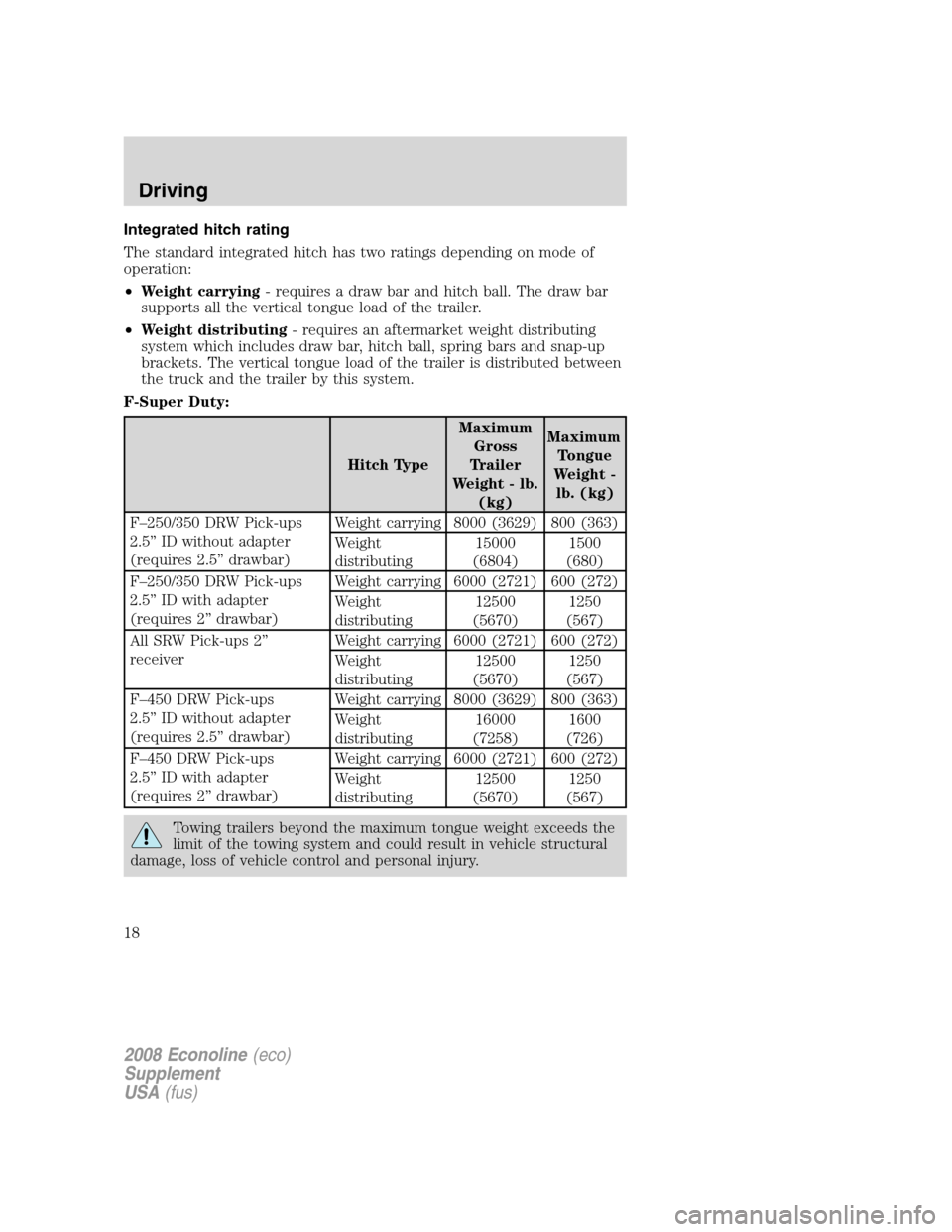
Integrated hitch rating
The standard integrated hitch has two ratings depending on mode of
operation:
•Weight carrying- requires a draw bar and hitch ball. The draw bar
supports all the vertical tongue load of the trailer.
•Weight distributing- requires an aftermarket weight distributing
system which includes draw bar, hitch ball, spring bars and snap-up
brackets. The vertical tongue load of the trailer is distributed between
the truck and the trailer by this system.
F-Super Duty:
Hitch TypeMaximum
Gross
Trailer
Weight - lb.
(kg)Maximum
Tongue
Weight -
lb. (kg)
F–250/350 DRW Pick-ups
2.5” ID without adapter
(requires 2.5” drawbar)Weight carrying 8000 (3629) 800 (363)
Weight
distributing15000
(6804)1500
(680)
F–250/350 DRW Pick-ups
2.5” ID with adapter
(requires 2” drawbar)Weight carrying 6000 (2721) 600 (272)
Weight
distributing12500
(5670)1250
(567)
All SRW Pick-ups 2”
receiverWeight carrying 6000 (2721) 600 (272)
Weight
distributing12500
(5670)1250
(567)
F–450 DRW Pick-ups
2.5” ID without adapter
(requires 2.5” drawbar)Weight carrying 8000 (3629) 800 (363)
Weight
distributing16000
(7258)1600
(726)
F–450 DRW Pick-ups
2.5” ID with adapter
(requires 2” drawbar)Weight carrying 6000 (2721) 600 (272)
Weight
distributing12500
(5670)1250
(567)
Towing trailers beyond the maximum tongue weight exceeds the
limit of the towing system and could result in vehicle structural
damage, loss of vehicle control and personal injury.
2008 Econoline(eco)
Supplement
USA(fus)
Driving
18
Page 22 of 96
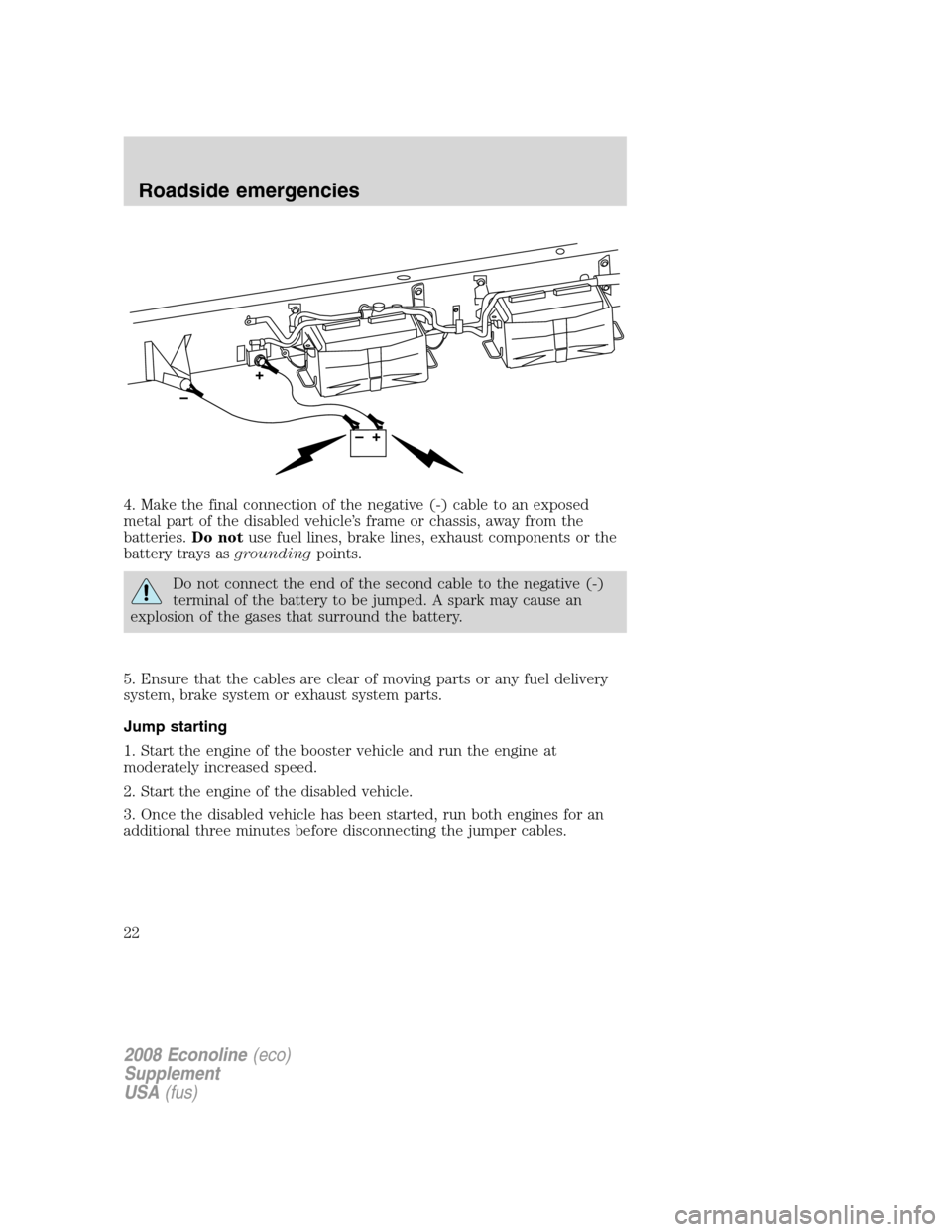
4. Make the final connection of the negative (-) cable to an exposed
metal part of the disabled vehicle’s frame or chassis, away from the
batteries.Do notuse fuel lines, brake lines, exhaust components or the
battery trays asgroundingpoints.
Do not connect the end of the second cable to the negative (-)
terminal of the battery to be jumped. A spark may cause an
explosion of the gases that surround the battery.
5. Ensure that the cables are clear of moving parts or any fuel delivery
system, brake system or exhaust system parts.
Jump starting
1. Start the engine of the booster vehicle and run the engine at
moderately increased speed.
2. Start the engine of the disabled vehicle.
3. Once the disabled vehicle has been started, run both engines for an
additional three minutes before disconnecting the jumper cables.
2008 Econoline(eco)
Supplement
USA(fus)
Roadside emergencies
22